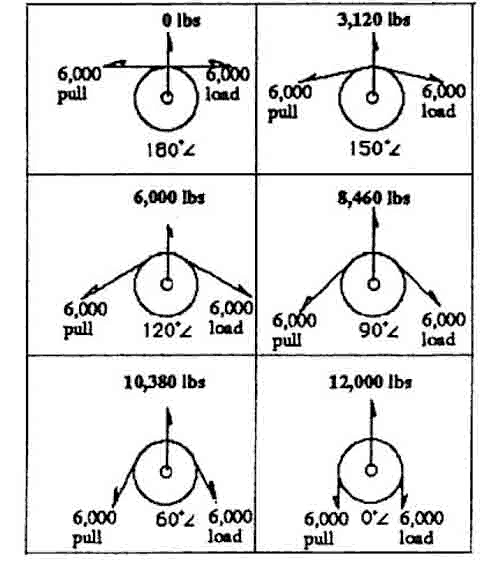Block and tackle rigging and skidding loads via winch and snatch blocks are tried and true rigging systems which are still actively used in underground mining, ship repair, power utility work, machinery installation/removal, logging and millwright jobs in many industries.
When setting up a block & tackle system, we want to know the weight of the load and rigging gear, the lead line pull necessary to hoist the load and the resulting load on the overhead support beam or head structure.
How many parts of line are working for us in the illustrated block & tackle system? Count the number of lines entering and exiting the traveling block. If we divide the load weight by this number, we’ll know the approximate tension on the lead line when the load is not in motion (static). 8,000 divided by 4 = 2,000 lbs.
Next we can determine the load line tension at the winch when the load is being hoisted by counting the number of line sections from dead end to winch end, in this case line sections A through H = 8.
Multiply that number (8) by 5% of the static line tension (2,000) which = 100 so that (8 x 100 = 800), then add the number 800 to the tension found in the last line section at the winch end (2,000). This new number 2,800 will be the lead line’s tension when the load is being hoisted (accounts for sheave friction and rope flexing).
(8 x (.05 x 2000)) + 2000 = 2800
The next area of concern is the load being introduced to the overhead beam support. We can estimate the load by adding the hoisting tensions of line sections A through E to arrive at the approximate load being put on the beam.
A = 2,100
B = 2,200
C = 2,300
D = 2,400
E = 2,500
Beam Tension =11,500 (plus rigging)
Another area to be addressed is the tension being placed on the snatch blocks. The example table below indicates the load factor to use, which should be multiplied by the line tension closest to the winch drum.
| Line Angle | Load Factor | Line Pull | Block Tension | ||
| 180 | 0 | x | 6000 | = | 0 |
| 150 | .52 | x | 6000 | = | 3,120 |
| 120 | 1.00 | x | 6000 | = | 6,000 |
| 90 | 1.41 | x | 6000 | = | 8,460 |
| 60
0 |
1.73
2.00 |
x
x |
6000
6000 |
=
= |
10,380
12,000 |
Now let’s see what the tensions are at block positions 1, 2, & 3 in the illustration.
Line section F @ 2,600 x 1.41 = 3,666 lbs tension in block #1
Line section G @ 2,700 x 1.73 = 4,671 lbs tension in block #2
Line section H @ 2,800 x .52 = 1,456 lbs tension in block #3
Happy Rigging, Mike Parnell.
PS – These concepts are illustrated very well in ITI’s Master Rigger Training.
This is an article from The Professional Rigger newsletter, 1989. To download this issue of The Professional Rigger, click Block & Tackle / Snatch Blocks.



